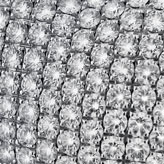Micropavé and other Microscope Set Jewelry

In the jewelry trade today, many retailers use the term micro pavé or microscope set, but what they do not tell you is that there can be a huge difference in the quality and therefore the value of the micro pavé set jewelry.
I often meet consumers who are mislead by a seller’s misuse of the term and aim to educate consumers. Don’t believe everything the sales person tells you – just take a little time to examine the overall quality of the craftsmanship to decide for yourself. I’ll tell you how.
What is micropavé set jewelry?
Pavé [pronounced ‘pah-vey‘] denotes the setting of stones placed close together so as to show very little to no metal between them. The “micro” part of it technically means that the diamonds or gemstones are set under a microscope. In a general sense, one can add ‘micro’ in front of any type of gemstone setting, such as pavé set, channel set, bezel set, prong set, etc. In the case of micropavé setting, it’s taken to another level when utilizing exceptionally small diamonds that effectively “wraps” or “encrusts” the surface of metal, creating a stunning, uniform glitter on the surface that is truly extravagant. Talk about bling!!
Why Set Jewelry with a Microscope? Precision.
Beware of micropavé impostures!
Sadly, many claim to be micropavé set just because the piece was set under a microscope. Remember that micropavé is the term used for the highly precise setting of small, uniformly placed diamonds or other precious stones that literally ‘pave’ the surface. The important consideration when purchasing a microscope set ring or pendant is: How good is the setter at using the microscope technique? This is based entirely on talent and the setter’s attention to detail. Lets face it, just because you give someone a pair of basketball shoes and explain the rules doesn’t mean that he or she will be a basketball superstar. The same is true for microscope setters.
Furthermore, this process demands absolute precision to securely fix the numerous stones into the jewelry, and losing a stone in this setting is like seeing a smile with a missing tooth!
A little on the process of true microscope jewelry setting
Let’s say that we’re making a platinum micropavé diamond ring. The design or shape of the ring does not matter – the process always starts out the same:
- We have the shape of the ring in raw platinum.
- We then precisely drill holes and cut prongs by hand directly out of the metal to prepare it for setting the diamonds. This step makes the prongs cleaner and shinier than a ring that has the prongs already pre-cut/pre-cast into the metal.
Note: In the interest of full disclosure, you should know that there are only a handful of setters that can execute this step in the process. This step is what separates a good setter from an exceptional setter. Most manufactures and jewelry designers skip this process in order to save time and money. They do this by pre-cutting the prongs into the the wax before casting the metal. The problem with this method is that when the casting (platinum) comes out, the jeweler cannot clean in between the prongs, thus leaving the areas in between the diamonds looking dull and unfinished.
- After selecting the correct and uniform size of diamonds, the next step would be to set the diamonds into the ring.
Examine the Setting!
So the next time you walk into a store and the salesman tells you that it is a micropavé setting, take a second look. Are the prongs nice and clean? Are the diamonds they used the same size? Are the diamonds set in a straight line? How clean is the overall job?
We here at Beach City Jewelers pride ourselves on:
- Setting each diamond straight
- Ensure that all diamonds are facing the same direction
- Low tolerance on diamond size variations to create that stunning, uniform sparkle
- Using ideal cut diamonds
